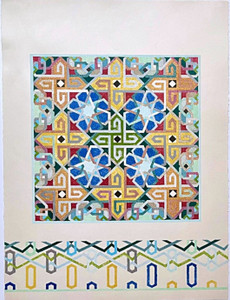
Joyce Kozloff
Topkapi Pullman, 1985
Watercolor and acrylic on paper (bears original gallery labels: Barbara Gladstone Gallery, Gallery Camino Real, Boston University Art Gallery)
Signed, and inscribed: "Mural for Lobby, Suburban Train Station, Philadelphia, to be executed in glass mosaic, 2"=1', Joyce Kozloff 1985."
Measurements:
Frame:
27 x 33 x 1 inch
Artwork:
23.5 x 30 inches
This showstopping, unique watercolor and acrylic work on paper is based upon of one of two mosaic panels for the Suburban Station, an art deco office building and underground commuter rail station in Penn Center, Philadelphia. It features elaborate floral and geometric motifs. According to published materials accompanying the Boston University Art Gallery exhibition, "Opposite the Penn mosaic stands “Topkapi Pullman,” paying tribute to Philadelphia’s role as a transportation and mercantile center. From inside Istanbul’s Topkapi Palace, tiled with elaborate floral and geometric motifs, a doorway opens up onto a massive, foreshortened locomotive speeding through a streamlined Precisionist space. The Art Deco train is modeled on Fix Masseau’s iconic 1929 Orient Express poster. It evokes the romanticism of train travel, and plays on its symbolism in 1930s movies, where it was a metaphor for sex, power and glamour. Above is the logo of the Pennsylvania
railroad, and below its motto, “The Standard Railroad of the World.”
(Regional commuters in the 1930s might have fantasized that they were
traveling on the luxurious Orient Express to Istanbul.) Bridging decoration and
illusion, the style and imagery acknowledge both fine and applied arts
traditions,
Kozloff has taken on many public commissions throughout her career.
The present work is signed, dated and inscribed on lower right recto in pencil: "Mural for Lobby, Suburban Train Station, Philadelphia, to be executed in glass mosaic, 2"=1', Joyce Kozloff 1985."
Three gallery labels on verso:
Barbara Gladstone Gallery
Gallery Camino Real
Boston University Art Gallery
Below is an excerpt from a transcript of Kozloff discussing the design and conceptual elements of the public mosaic work that the present work is a study of:
Joyce Kozloff: Suburban Station, Philadelphia
“Galla Placidia in Philadelphia” and “Topkapi Pullman,” 1 Penn Center at
Suburban Station, Philadelphia, PA, Richard I. Rubin & Co., Developer;
Francis, Cauffman, Wilkinson and Pepper, Philadelphia, Architects; fabricated
by Travisanutto Mosaics, Spilimbergo, IT; photos Eugene Mopsik
Two mosaic panels integrate local history with early moments in the history of
Western art. In “Galla Placidia in Philadelphia,” William Penn stands on a
schematic hillside, holding the scrolled charter to the commonwealth of
Pennsylvania. He functions as an historical referent and schematic visual
symbol, for his silhouette is the primary civic icon of the city. Penn is set into an
ornate architectural ensemble based on the mausoleum of Galla Placidia in
Ravenna. Although the wall surface is only slightly convex, the impression is of
a lunette set deeply into one of the arms of a chapel’s Greek cross floor plan.
Flat, ornamented archivolts outline this illusionistic space and separate it from a
two-dimensional starry night abstracted from the patterned constellations on the
ceiling in Ravenna. Penn replaces the Christian saints at Galla Placidia, but the
forms of their attributes remain, so he is shielded by the protective canopy of
Early Byzantine art, but the flames of maryrdom which encircle his feet are
now de-contextualized, retained for their decorative effect.
Opposite the Penn mosaic stands “Topkapi Pullman,” paying tribute to
Philadelphia’s role as a transportation and mercantile center. From inside
Istanbul’s Topkapi Palace, tiled with elaborate floral and geometric motifs, a
doorway opens up onto a massive, foreshortened locomotive speeding through
a streamlined Precisionist space. The Art Deco train is modeled on Fix Masseau’s iconic 1929 Orient Express poster. It evokes the romanticism of
train travel, and plays on its symbolism in 1930s movies, where it was a
metaphor for sex, power and glamour. Above is the logo of the Pennsylvania
railroad, and below its motto, “The Standard Railroad of the World.”
(Regional commuters in the 1930s might have fantasized that they were
traveling on the luxurious Orient Express to Istanbul.) Bridging decoration and
illusion, the style and imagery acknowledge both fine and applied arts
traditions, signifying the artist’s intention to break down the barriers between
them.
Text excerpted from Pat Johnston, Joyce Kozloff: Visionary Ornament. Boston,
MA: Boston University, 1985.
Very good condition with no apparent issues; floated in elegant hand made white wood frame with museum plexiglass












